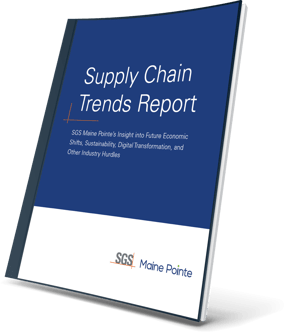Artificial Intelligence in the supply chain
The term “artificial intelligence” (AI) has taken on almost magical properties. As supported by both statistical trends and current applications, AI does offer clear benefits to the supply chain, from planning through procurement, operations, and logistics, as supported both by statistical trends and current applications.
However, as with any business case, proponents of AI need to:
- Define the specific, measurable, achievable, relevant, and time-bound (SMART) goals that AI is expected to help achieve.
- Clearly articulate the business problem that AI is supposed to solve that traditional methods can’t.
- Show the value added: reduced costs, greater productivity, improved decision making, and so on.
- Ensure that the company has the data, tools, and skilled personnel to implement and maintain.
- Identify the risk, including security, regulatory compliance, and bias concerns.
- Acquire the specialized skill sets needed to evaluate, implement, and maintain AI.
- Define and monitor KPIs.
Many companies are able to support the business case but falter when it comes to determining how their material flow and layout needs to change to support AI and how AI will change what people do and the way they do it. They also tend to overestimate the amount of time it takes to ramp up, the amount of improvement to expect, and the time and resources it will take to gain the value they expect.
AI trends by the numbers
Companies believe AI will help with:
- Labor shortages: 25%
- Customer relations: 64%
- Productivity: 64%
- Written content: 54%
Companies worry about:
- Consumer concerns about misinformation: 75%
- Lack of technical skills: 35%
Companies anticipate:
- Using AI in future: 44%
- Annual growth of AI, 2023-2030: 37.3%
- Workers displaced by AI: 400M
Benefits of AI for the end-to-end supply chain
Narrow AI applications are those that are specialized, such as image and speech recognition and natural language processing (as with chat applications). Artificial general intelligence (AGI) or strong AI has the capability of thinking and acting similarly to humans; it is capable of learning on its own and can transfer knowledge to new tasks.
Every current application of AI fits into the “narrow” category, including predictive and prescriptive analytics, and automation. Strong AI is still theoretical. Yet, even the narrow AI applications deliver tremendous benefits to companies.
On the planning side, AI’s ability to process and analyze large volumes of data helps companies to fully visualize their plan-make-buy-move supply chains and made more informed decisions. Self-generated reports and AI-based vision boards enable decision makers to organize, interpret, and use data in a form aligned with their specific needs.
In procurement, AI can analyze current and historical supplier data on pricing, quality, and performance metrics to recommend the best suppliers. It can also predict potential supplier risks and provide insights for effective supplier relationship management. By monitoring current market fluctuations and using historical data, AI can better predict demand and thereby give procurement the data it needs to negotiate with suppliers. AI-powered tools can categorize and analyze spending patterns across the organization, helping identify cost-saving opportunities and areas of potential waste.
In operations, AI automates routine and repetitive tasks, freeing up employees to focus on more complex and value-added activities. Using monitoring sensors and cameras, it quickly detects anomalies and variations in quality, predicts when equipment needs maintenance, optimizes resources and energy consumption, and identifies bottlenecks and inefficiencies.
In logistics, AI can analyze real-time traffic data, weather conditions, and historical delivery patterns to optimize delivery routes and avoid delivery risks. By forecasting demand and monitoring inventory levels, it helps companies avoid both stockouts and excess stock. With analyses and more efficient last mile delivery, AI improves customer service. As in operations, AI robots and systems can automate and speed up repetitive tasks, such as sorting and picking.
5 ways to ensure AI’s potential is realized
Companies can realize the full potential of AI applications by implementing a comprehensive strategy that encompasses various stages of planning, implementation, and continuous improvement. They will have more success if they start with standard operating procedures for their current processes and for the AI implementation, ensure that all stakeholders are onboard, and scale up gradually. The principle activities in any implementation are to:
- Gather Data: Gather trustworthy data from sensors, historical records, maintenance logs, and more; standardize the data; and organize it in a way suitable for AI algorithms. Timely, accurate, complete data depends on eliminating silos between functions and business units and ensuring that everyone understands the goals.
- Analyze: Analyze their current processes to identify areas where AI can add value that cannot be added by other means. An analysis of network design and footprint, product lifecycle management, and the end-to-end supply chain will often indicate areas where improvements should be made before problems as well as solutions become solidified with technology.
- Investigate: Choose appropriate AI techniques such as machine learning, deep learning, computer vision, natural language processing, and reinforcement learning based on the specific use cases. Develop and train AI models using the data by selecting algorithms, tuning hyperparameters, and validating the models to ensure they perform well.
- Integrate: Integrate the trained AI models into the processes and systems seamlessly. This may involve collaboration between data scientists, engineers, and domain experts. Implement real-time monitoring and analysis to detect anomalies in processes and optimize them.
- Monitor and Measure: Continuously monitor the performance of AI applications using KPIs such as cost savings, efficiency gains, and increased throughput. Fine-tune and update AI models as necessary to adapt to changing conditions, new data, and evolving requirements. Measure the impact of AI implementation by tracking key performance indicators (KPIs) such as cost savings, efficiency gains, quality improvements, and increased throughput.
- Secure: Implement robust security measures to protect sensitive manufacturing data used by AI systems. Ensure compliance with data privacy regulations and industry standards.
AI increases the efficiency, productivity, and cost control in planning, procurement, operations, and logistics. It leads to data-based decisions that are more aligned with reality. The difficulties that companies face when implementing AI come from limitations in their current processes and systems and from unrealistic expectations. By making and sharing the business case, gathering data, analyzing current processes, investigating different AI technologies, gradually integrating AI, monitoring the effects with clearly defined metrics, and securing the system against cyber-attacks, companies will bolster their ability to benefit from AI across the supply chain.
Related Resources
Ready to improve your consumer demand forecasting?

Talk to us
From rapid sprints for short-term gains to transformation for competitive advantage we are here to get you there.
Schedule a discussion
Submit this form to speak to an SGS Maine Pointe representative.
Prefer a call? (781) 934 - 5569




